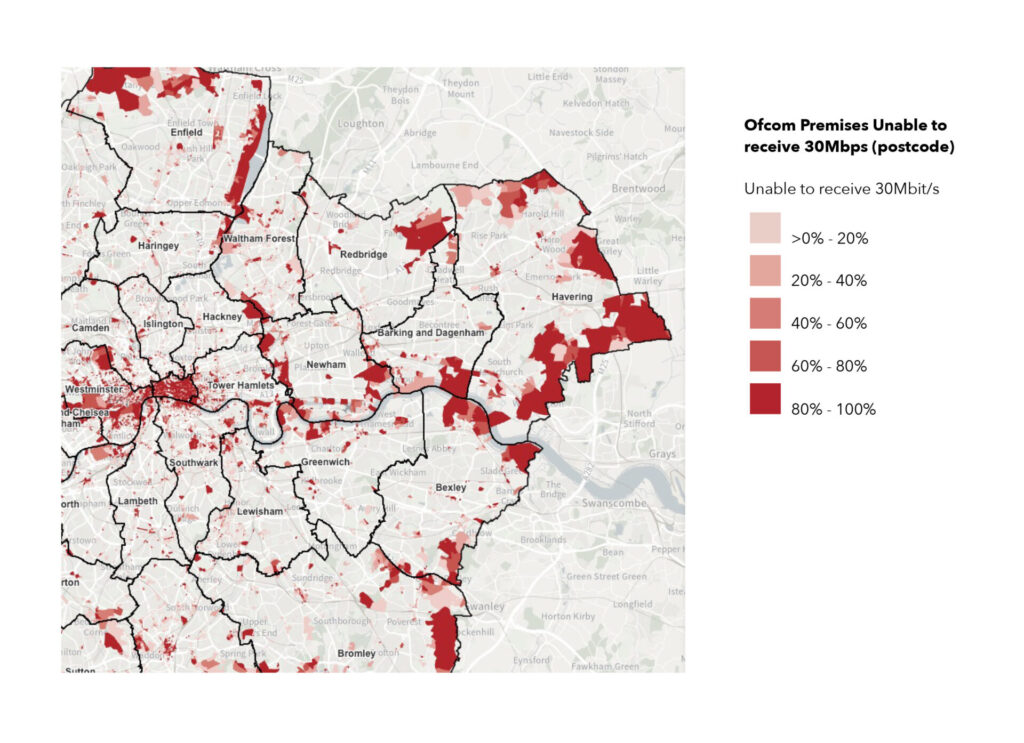
- 20th May 2025
- Back to All News


ITS and Local London convene leaders to support inclusive growth and strengthen the case for digital investment across London’s fastest-growing boroughs.
A clear message is taking shape among public and private sector leaders: to unlock Local London’s digital potential, we need stronger collaboration, clearer national policy, and a louder, united voice to put the sub-region’s priorities on the map.
That was a standout takeaway from a recent cross-sector conversation hosted jointly by ITS — operator of the UK’s largest dedicated business-grade full fibre network – and local authority group, Local London. The session brought together senior voices from local government, industry, and regional organisations to explore how digital infrastructure can drive economic growth, improve public services, and deliver inclusive opportunity across Local London.
Local London — a sub-regional partnership of nine boroughs — is home to 2.6 million residents and 100,000 businesses, making it larger than the cities of Birmingham, Manchester and Liverpool combined. It is also London’s fastest-growing area, yet investment in digital infrastructure has not kept pace. More than 114,000 homes and businesses across the boroughs still lack access to gigabit-capable connectivity.
Above all, attendees stressed the need for a unified narrative. While many boroughs are leading valuable local initiatives, leaders agreed that a more compelling, collective story must be told — one that links digital infrastructure directly to wider outcomes in education, skills, mobility, housing, and innovation.
This shared voice, they argued, is essential to unlocking national recognition and securing the long-term investment needed to drive fair, sustainable growth.
The conversation built on the ambitions set out in the Fair Economic Growth through Digital Connectivity paper from Thames Estuary Growth Board, which positions the region as the UK’s next AI and digital powerhouse. Sharing geography and ambitions with the Thames Estuary, participants supported the report’s call for bold public-private collaboration to accelerate progress across the region.
Local London is seeking investment across its boroughs to:
⇒Read our Delivering Economic Growth in Local London: Digital Connectivity Requirements paper.
“There is real opportunity across this part of London and the wider Estuary corridor,” said Daren Baythorpe, CEO of ITS. “The boroughs that make up Local London have the scale, the ambition, and the economic weight to help lead the UK’s digital future — but this can only be realised if we get the right infrastructure in place. We were pleased to support a conversation focused on moving forward, together.”
Mayor Rokhsana Fiaz OBE, Chair of Local London’s Growth Board that leads on digital and Mayor of Newham, reinforced this direction:
“Digital inclusion is vital for people in our boroughs. Yet across Local London there are over 100,000 premises with no or only the lowest level of digital connectivity and this is curtailing opportunities for people and businesses.
That’s why we are committed to working with private and public sector partners to close this digital divide. It is only through wide collaboration and appropriate investment that we will bring high-speed connectivity to east London, and out into the Thames Estuary. This is fundamental for digital inclusion and our joint vision to lead the UK’s AI and digital future.”
ITS remains committed to supporting Local London’s ambitions — by convening conversation, sharing delivery insight, and contributing to the infrastructure required to build a more connected, resilient, and inclusive future.
Mayor Rokhsana Fiaz OBE, Chair of Local London’s Growth Board that leads on digital is the Mayor of Newham and also Data and Innovation lead for London Councils. She will be one of our Leaders speaking at UKREiiF – the UK’s leading real estate infrastructure and investment forum – in Leeds 20-22 May 2025.
Discover more about our digital infrastructure asks.
Digital connectivity is fundamental to unlocking growth across our sub-region and beyond.
We were delighted to share insights into digital investment needs across our boroughs in the Thames Estuary Growth Board’s recently launched ‘Fair Economic Growth through Digital Connectivity’ paper.
The paper sets out the Growth Board’s plan to establish the Thames Estuary region as the UK’s next AI and digital powerhouse. We back the Board’s call to action for targeted support and bold public-private sector collaboration across east London, north Kent and south Essex to drive forward the UK’s digital future.
While we have secured around £20m investment into our boroughs to improve digital connectivity, our research highlights barriers preventing us from achieving ubiquitous world-class connectivity befitting of expectation of being part of London.
As a result, we need additional funding to:

⇒Read our Delivering Economic Growth in Local London: Digital Connectivity Requirements paper.
Cllr Anthony Okereke, Chair of Local London and Leader of the Royal Borough of Greenwich, said “As the fastest growing part of the capital with a population greater than the cities of Birmingham, Manchester and Liverpool combined, we welcome the Thames Estuary Growth Board’s position paper. We are committed to creating inclusive growth for people and businesses in our sub-region; investment in digital infrastructure to tackle over 100,000 premises without gigabit capable broadband connectivity is fundamental to achieving this and supporting local, regional and national economic growth.”
Mayor Rokhsana Fiaz OBE, Local London representative of the Thames Estuary Growth Board and Mayor of Newham London, said “We know that digital inclusion is vital for our people as the impact of technology and the digital age is changing how we live and accessibility will inform life chances. The government has placed a priority on addressing digital access because the digital exclusion numbers are stark, with 1.6 million people in the UK currently not online. Across the Local London area it is even more pronounced, with 100,000 premises not connected or amongst the lowest level of digital capability meaning that the opportunities of life are curtailed.
That’s why we have an ambition through our involvement in the Thames Estuary digital corridor, which will bring high-speed connectivity to east London as this report sets out. It will enable digital inclusion for our people so that they can seize the opportunities of economic growth, over sustaining digital ‘not spots’ which is holding our people back. That’s why fair economic growth through digital connectivity in our boroughs and across the Thames Estuary region is a must.”
Below: map showing slow and no connectivity areas in Local London boroughs and beyond.
The Thames Estuary region, one of two nationally important growth corridors intersecting the Local London sub-region, has the potential to add £190bn to the UK economy by 2050[1].
The Local London economy represents around £55bn[2], with potential to increase with the right investment. Our boroughs are working together through Local London to unlock sustainable inclusive growth across north east and south east London.
[2] ONS snapshot data from 2022 (not adjusting for inflation)
Over 150,000 premises in south and east London do not have access to high speed – Gigabit capable – internet connections.
Contrary to perception, hundreds of thousands of addresses in London are affected by slow digital connectivity, causing digital inequalities that impede the lives of people and businesses.
The ‘Sub-regional Digital Infrastructure Strategy’ launched today by Local London and the South London Partnership, identifies gaps in 14 south and east London boroughs. It includes recommendations for driving up the quality and accessibility of services in them and will help channel investment to areas of economic opportunity.
There are over 103,000 premises in Local London and 53,000 South London Partnership unable to obtain a Gigabit capable broadband service with many sitting in a ‘not spot,’ unable to receive even a 30 Mbps service.
Mapping out the digitally poor postcodes, the strategy highlights best practices, learning and actions that the public and private sector can take together to build world-leading digital infrastructure for some of the fastest growing parts of London.
Commissioned by the Mayor of London’s Infrastructure Coordination Service, the ‘Sub-regional Digital Infrastructure Strategy’ is part of a wider pilot which will deliver an interactive mapping tool and an online digital toolkit that will assist borough officers to deliver digital infrastructure to their sites and leverage additional commercial digital infrastructure investment in the sub-regions.
The ‘Sub-regional Digital Infrastructure Strategy’ provides a compelling argument for actively pursuing digital investment along with step-by-step guidance to public sector officers to attract investment and promote better quality and more accessible services, including:
Theo Blackwell MBE, Chief Digital Officer, Greater London Authority said “Widely available, easily accessible digital connectivity is essential for people to reach public services and is key to helping cities grow through driving innovation and the creation of new businesses.
“Yet there are still parts of London that suffer from a lack of commercial investment in digital infrastructure, and this results in gaps in internet coverage or ‘not spots’.
“We must address these gaps and drive up the quality and accessibility of the services that are already available, to help the capital to be a fairer, more prosperous, and more equal London for everyone.”
Cllr Baroness O’Neill of Bexley OBE, Chairman of Local London and Leader of London Borough of Bexley said “We are delighted to launch the ‘Sub-regional Digital Infrastructure Strategy’ with our colleagues at South London Partnership. This provides step-by-step guidance to public sector colleagues for unlocking inward investment and maximising existing infrastructure to benefit people and businesses in the area. Along with the database and digital toolkit, this pilot approach will help all 14 boroughs tackle the digital divide, whilst also creating a legacy of learning that have even wider benefits.”
Cllr Gareth Roberts, Chair, South London Partnership and Leader of London Borough of Richmond upon Thames Council commented “This joint strategy demonstrates the benefits of a cross-boundary approach. Addressing the issues at a sub-regional level, with colleagues at Local London, this strategy provides clear guidance for unlocking rapid deployment of next generation wireless infrastructure and gigabit capable full fibre, to align us with other urban areas in the UK, whilst responding to the distinct social and economic needs of each borough.”
— Ends —
About the London Digital Toolkit
The ‘Sub-regional Digital Infrastructure Strategy’ can be found on the newly launched London Digital Toolkit site. This site provides an overview of the digital landscape, plus guidance and resources to assist borough officers to deliver digital infrastructure to their sites and leverage additional commercial digital infrastructure investment. Find out more: londondigitaltoolkit.org.uk
Statistic quoted above are based on latest figures available from Ofcom Connected Nations research published December 2023.
About Local London
Local London is a sub-regional partnership of nine boroughs: Barking and Dagenham, Bexley, Bromley, Enfield, Greenwich, Havering, Newham, Redbridge and Waltham Forest.
Working together, we are a stronger voice and find solutions to common problems that affect our 2.6 million residents and 100,000 businesses in our nine boroughs.
Find out more: www.local.london
About South London Partnership
The South London Partnership is a sub-regional collaboration of Croydon, Kingston-upon-Thames, Merton, Richmond-upon-Thames and Sutton Councils. Together they make up a vibrant sub-region with 1.2 million residents and a £32 billion pre-Covid economy, the recovery and future vitality of which our boroughs are committed to supporting.
Find out more: southlondonpartnership.co.uk
Contact
For press enquiries, contact Helen McKay, Local London, helen.mckay@redbridge.gov.uk